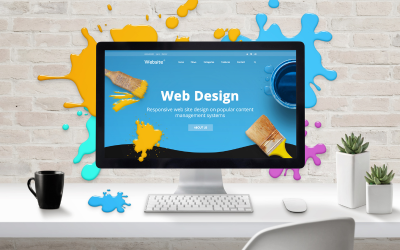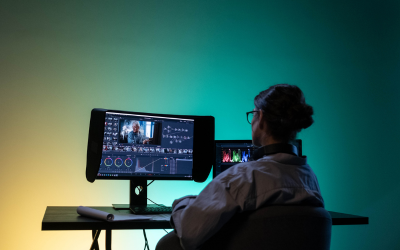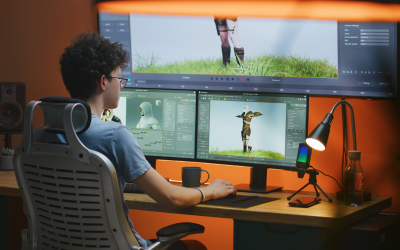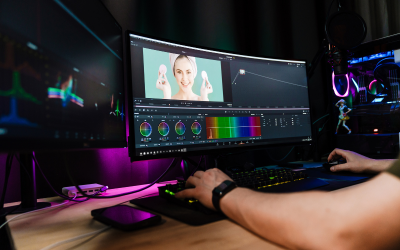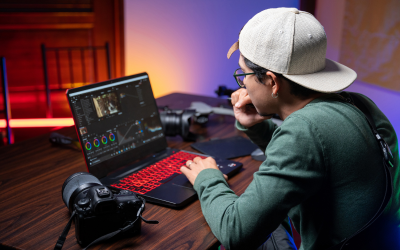Highlights: - Introduction to Video Editing: Learn the fundamentals of video editing, including the key concepts, techniques, and processes used in professional video production. - Video Editing Softw...
Highlights:
- Introduction to Video Editing: Learn the fundamentals of video editing, including the key concepts, techniques, and processes used in professional video production. - Video Editing Software: Gain hands-on experience with industry-standard software like AdobePremiere Pro, Final Cut Pro, and DaVinci Resolve. - Editing Techniques & Workflow: Understand the step-by-step process of video editing, fromimporting footage to final output. - Advanced Editing Skills: Learn how to use advanced techniques like color grading, sound editing, motion graphics, and visual effects to enhance your videos. - Storytelling through Editing: Master the art of editing to tell a compelling and visually engagingstory.
Course Objective:
By the end of this course, you will be able to: - Understand the principles of video editing and its role in storytelling. - Use industry-standard video editing software to create polished video content. - Develop an effective editing workflow from start to finish. - Apply advanced editing techniques, including color correction, sound editing, and visual effects. - Produce high-quality video projects for various platforms, including film, TV, social media, andadvertising. - Build a professional video editing portfolio showcasing your work
Course Structure:
1. Introduction to Video Editing
- Overview of video editing: Key concepts and terminology. - The role of an editor in the video production process. - Introduction to industry-standard video editing software: Adobe Premiere Pro, Final Cut Pro, DaVinci Resolve. - Setting up your editing workspace and understanding the timeline, bins, and sequences
2. Basic Editing Techniques
- Understanding the editing process: From rough cut to final edit. - Importing and organizing footage efficiently. - Cutting and trimming clips: Basic editing tools and shortcuts. - Working with transitions: Creating smooth visual flows between scenes. - Basic video effects: Applying filters, motion, and basic color correction
3. Audio Editing and Sound Design
- The importance of sound in video editing: Syncing audio with video. - Editing dialogue, sound effects, and music to enhance the visual story. - Using audio tools to clean up and enhance sound quality. - Working with multiple audio tracks: Mixing, balancing, and mastering audio.
4. Color Grading and Correction
- Understanding color theory and its importance in video editing. - Introduction to color grading tools and techniques in software like DaVinci Resolve and PremierePro. - Basic color correction: Fixing exposure, contrast, and white balance. - Advanced color grading techniques: Creating mood and enhancing visual style.
5. Advanced Video Editing Techniques
- Working with multi-camera footage: Syncing and editing from multiple angles. - Creating advanced transitions and motion effects. - Integrating visual effects (VFX) into your video project. - Using time remapping and slow-motion for creative storytelling.
- Advanced editing workflows for large-scale projects
6. Motion Graphics & Visual Effects in Video Editing
- Introduction to motion graphics: Creating animated titles and lower-thirds. - Working with Adobe After Effects to create and integrate motion graphics into your edits. - Using visual effects to enhance storytelling: Creating dynamic visuals with VFX. - Integrating 2D and 3D elements into your video timeline
7. Editing for Different Platforms
- Understanding the requirements for editing videos for various platforms: YouTube, social media, TV, and film. - Exporting and optimizing videos for specific platforms: File formats, resolution, and aspect ratios. - Creating videos for specific genres: Promotional content, documentaries, music videos, andnarrative films. - Understanding the difference between editing for traditional media and digital media
8. Portfolio Development & Final Project
- Building a professional video editing portfolio: Organizing and presenting your work. - Collaborative editing: Working in teams and managing multiple editors on a project. - Final project: Edit a complete video piece, from rough cut to final output, incorporating all learnedtechniques. - Preparing for industry-specific job roles: Video editor, post-production assistant, and sounddesigner.
Learning Methodology: -
Interactive Lectures: Learn key editing concepts, techniques, and workflows through structuredlessons. - Hands-on Practice: Edit real-world video projects using industry-standard software. - Assessments & Quizzes: Participate in regular assignments and tests to reinforce learning. - Live Sessions: Engage with instructors in live Q&A sessions to receive feedback on your work. - Discussion Forums: Connect with peers to discuss editing challenges and share tips and tricks.
Who Should Enroll:
- Aspiring video editors who want to learn the craft of editing for professional media. - Filmmakers, content creators, and video production professionals who want to improve their
editing skills. - Marketing and social media professionals looking to create engaging video content. - Students and individuals seeking a career in post-production and video editing. - Anyone interested in creating high-quality videos for film, television, advertising, or digital
platforms.
This Video Editing course is ideal for anyone looking to break into the world of post-productionandvideo editing. Whether you're a beginner or someone with basic knowledge looking to refine your
skills, this course will provide you with the tools and techniques needed to create professional- quality videos. By mastering video editing software and advanced editing techniques, you'll beprepared to take on real-world projects and build a portfolio that stands out in the competitivemedia industry


